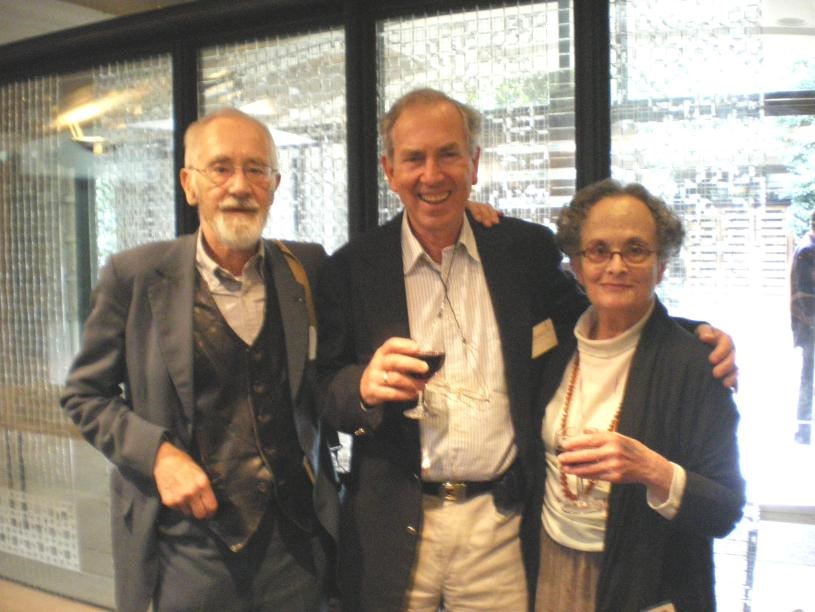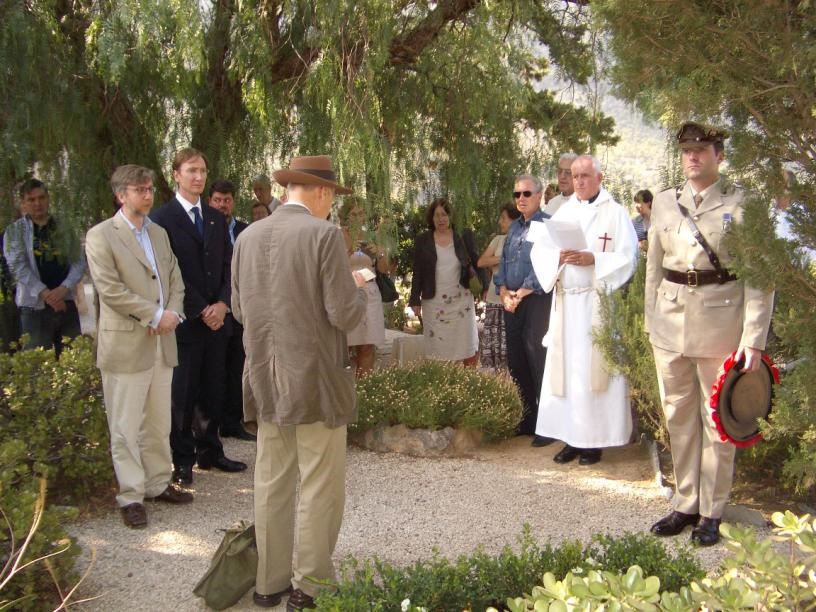|
Search Help |
|
Links Robert Graves Website Other RG Resources |

Obituaries
A Personal Memory: Alan Sillitoe (1928 -2010)
 Alan Sillitoe with William Graves and Ruth Fainlight, Oxford 2008
Alan Sillitoe with William Graves and Ruth Fainlight, Oxford 2008
The poet sings his poems on a bridge
A bridge open to horizontal rain
And the steely nudge of lightning,
Or icy moths that bring slow death
Croon him to sleep by snow-wings touching his eyes.
[from „The Poet‟, 1968]
Alan Sillitoe, poet and novelist, who died on 25 April 2010, aged 82, was a life-long friend of my family. He also had many good friends among the members of the Robert Graves Society, of
which he was a prominent and much-loved contributor. Nobody who was there that November night in 1995, in the packed hall at La Residencia (Deyá), will forget listening to Alan reading Robert‟s poems together with his wife, the poet Ruth Fainlight.
That night, Alan interspersed his reading with reminiscences of Robert, describing their first encounter in 1953 – Alan riding up from Sóller on a hired bike – and their subsequent connections over the years on both literary and personal levels. To end the evening, he pulled out his Morse key and tapped a message of greetings from us all, for Robert to receive in the world beyond.

Alan reading at the wreath-laying, Deyá, 2006
Alan delighted us with many other readings over the years, at various Robert Graves conferences, at the Madrid exhibition in 2002 and, most recently, at the Oxford Conference of 2008, where he read a selection of Robert‟s letters to him. Perhaps the most memorable of his poetry readings was at the wreath-laying ceremony to mark the Ninetieth Anniversary of the Battle of the Somme: we‟ll all remember Alan, standing by Robert‟s grave in
the Deyá cemetery, his head bowed as he read, his words echoing in our hearts. The two Royal Welch Fusiliers who had been flown over from Cyprus to take part in the ceremony were offered a cigar each by Alan – apparently Robert had told him to do just that whenever he came across a member of his old regiment.
A few days later, on 12 July 2006, Alan sent me a trench map dated May 1916 of the High Wood area, where Robert was wounded during the Battle of the Somme. „I‟m sure you‟ll like to have it,‟ he wrote. „He may well as a captain have carried a copy in his tunic when the shrapnel struck, or seen one before he went into the attack.‟ I treasure that gift – probably the very map that inspired his poem „Somme‟. Alan‟s love of maps and his Morsecode knowledge dated back to the days when, still a teenager, he served as a wireless operator for the RAF in Malaya at the start of the Emergency. After he was discharged from the army in 1948 he was diagnosed with TB and had to spend almost a year recovering in a sanatorium – a time during which he became an avid reader and turned his full attention to literature and to writing. So when, as a ten-year-old, I first met Alan in Mallorca, his writing life had only just begun.
Already then, he thought of himself primarily as a poet. „When I became a writer it was as a poet,‟ he explains in the introduction to his Collected Poems (1993), „but it didn‟t take long for fiction to obtrude, perhaps to fill in those spaces which must necessarily exist between one poem and another, my temperament having decided that during my life I could not be permitted to be unoccupied for a moment. Such periods of emptiness, being too fearful to contemplate, were duly filled, and have been so ever since.‟ Much has been written and discussed about the content and themes of his work, and the „angry young man‟ label he was always trying to escape. Alan cared and felt deeply about many issues and these pulsate both within and beyond the world of Arthur Seaton and his other fictional characters. Not enough has been said about his poetry, about its powerful combination of clear language and deep emotional insight, a voice which can also be heard in his prose. Take, for example, these words from A Man of
His Time (2004):
He didn‟t see her glare of loathing but he knew it was there. Not with all the tools in the forge would he be able to cut a way through the wall of her dislike, supposing he cared to, which in some way he did.
I hold many good memories of Alan – in particular those evenings at his London flat with Ruth during the last fifteen years or so. Alan, in his leather waistcoat, with his welcoming smile. Those lovely meals in the kitchen at the end of the corridor and down the steps: kippers and gherkins, Ruth‟s delicious soups or casseroles, the French wine and the shots of vodka. And then the pipe and the conversation in the drawing room. Books everywhere. His warmth, his generosity, his humanity and his refreshing sincerity are just a few of the things we shall all miss. But his words remain. And it was, of course, Ruth, his soul mate, who always kept the back door of poetry open for Alan, as he so perfectly put it in these lines:
You are the harvest of this world,
Opening each back door to
Stepping stones through tortuous wayfaring.
[from „Perplexed, placed as I am‟, 1960]
London, June 2010